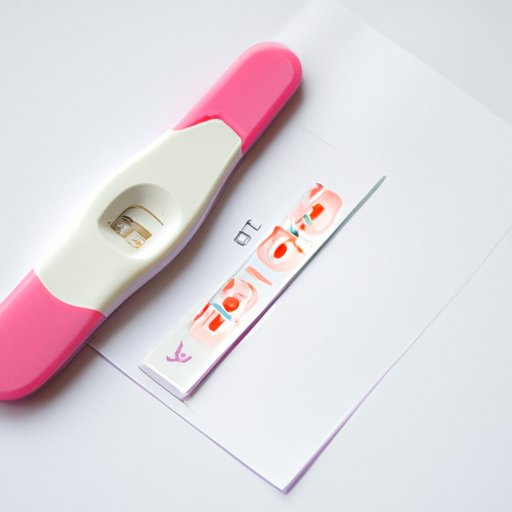
Introduction
Discovering that you’re pregnant can be an exciting, emotional, and sometimes daunting experience. Many women are eager to find out as soon as possible if they’re expecting, but knowing when and how to take a pregnancy test can be confusing. In this article, we’ll explore the early signs of pregnancy, the different types of pregnancy tests, how ovulation impacts pregnancy detection, factors that can affect test accuracy, and what to do if you receive an unexpected result. We hope this guide will help you navigate the journey of pregnancy and feel more prepared for the road ahead.
The early signs of pregnancy: How to recognize them
Some of the most common early signs of pregnancy include a missed period, nausea, fatigue, and breast tenderness. However, every woman’s experience of pregnancy symptoms is different, and some may not experience any symptoms at all at first. It can be challenging to recognize these early signs and determine if they’re related to pregnancy or something else entirely. It’s essential to listen to your body and talk to a healthcare provider if you have any concerns.
Home pregnancy tests: When and how to take them
Home pregnancy tests (HPTs) work by detecting the presence of the hormone human chorionic gonadotropin (hCG) in urine. It’s typically recommended to take an HPT at least one week after a missed period for accurate results. It’s essential to choose a reliable test and follow the instructions carefully to get accurate results. Some tips for using HPTs include testing first thing in the morning when hCG levels are highest, avoiding excessive fluid intake before testing, and waiting the recommended time for results to appear.
Blood pregnancy tests: How they work and what to expect
Blood pregnancy tests (BPTs) are another option for detecting hCG and can provide more accurate results earlier in pregnancy than HPTs. BPTs measure the quantity of hCG in the blood and are available in qualitative and quantitative forms. A qualitative test can only determine the presence or absence of hCG, while a quantitative test can measure the exact amount. You may need a BPT if you experience symptoms such as abdominal pain or abnormal bleeding. The test involves drawing blood in a lab and typically takes a few days to receive results.
The role of ovulation in finding out if you’re pregnant
Ovulation is the process of releasing an egg from the ovary, which can increase the chances of pregnancy if it’s fertilized by a sperm. Tracking ovulation can help identify the best time to conceive and may also impact how soon you can detect pregnancy. Ovulation tests detect luteinizing hormone (LH) in urine, which rises about 24-48 hours before ovulation. Pregnancy tests, on the other hand, detect hCG after implantation occurs, which typically takes 6-10 days after fertilization. Factors that can impact ovulation include age, stress, and certain medical conditions such as polycystic ovary syndrome (PCOS).
How certain health conditions can affect pregnancy test accuracy
Several health conditions and medications can cause false-positive or false-negative pregnancy test results. These include hormonal imbalances, certain types of cancer, and fertility treatments like IVF. It’s important to talk to a healthcare provider if you suspect a health condition may be affecting your hormone levels or pregnancy test accuracy. They may recommend additional testing or treatment.
Factors that impact the accuracy of pregnancy tests
Aside from health conditions, other factors can affect the accuracy of pregnancy tests. These include using expired tests, improper storage of tests, and user error such as misreading or misinterpreting results. Some tips for getting reliable results include checking expiration dates, storing tests in a dry, cool place, and following instructions precisely. It’s also important to note that some medications like diuretics or antihistamines may interfere with test results.
What to do if you receive a false-positive or false-negative result
False-positive and false-negative pregnancy test results can be distressing and confusing. A false-positive result occurs when a test indicates a positive result when no pregnancy exists, while a false-negative result indicates a negative result when a pregnancy does exist. Possible causes of each include faulty tests, medication use, or an ectopic pregnancy. If you receive an unexpected result, it’s essential to reach out to a healthcare provider for additional testing or clarification. They can provide insight into the possible causes of the result and offer solutions or recommendations for moving forward.
Conclusion
Discovering you’re pregnant can be a thrilling and life-changing experience. Whether you’re trying to conceive or suspect you may be pregnant, it’s essential to have accurate information about early signs, pregnancy tests, and factors that can affect accuracy. By understanding how pregnancy tests work, tracking ovulation, and seeking medical advice, you can feel more confident and informed throughout your pregnancy journey. Remember, every woman’s experience is different, and there’s no one ‘right’ way to navigate pregnancy. We hope this guide has provided helpful insights and support as you embark on this exciting new chapter in your life.





